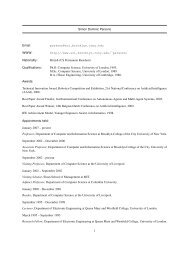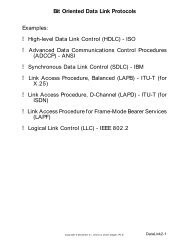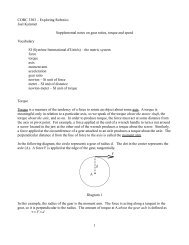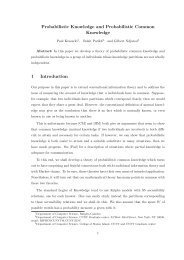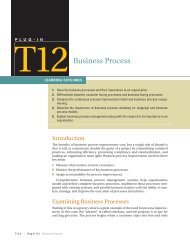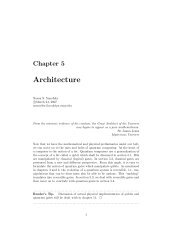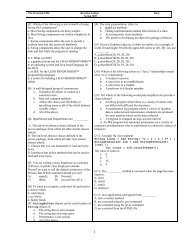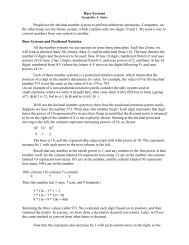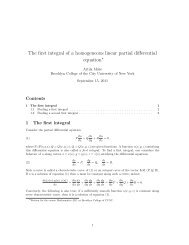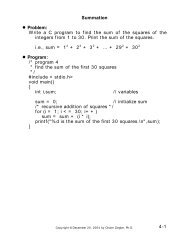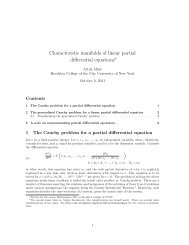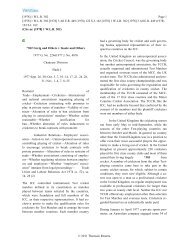CORC 3303 Review
CORC 3303 Review
CORC 3303 Review
You also want an ePaper? Increase the reach of your titles
YUMPU automatically turns print PDFs into web optimized ePapers that Google loves.
Notes about the final exam:<br />
1) You can bring one sheet of notes to the final exam. It has to be a letter-sized (8.5” x 11”) paper, two sided is fine,<br />
any size of font you can read.<br />
2) NO electronic devices, including your phone, can be used during the exam.<br />
Areas of interest<br />
<strong>CORC</strong> <strong>3303</strong> <strong>Review</strong><br />
1. Fundamentals of Robotics and their relationship to case studies<br />
2. Familiarity with the Lego RCX kit (parts) and the RoboLab software<br />
3. Introduction to elementary programming with a GUI environment<br />
1. FUNDAMENTALS<br />
A. Introduction to Robots<br />
What is a robot? (autonomous embodied agent)<br />
History, where does the term come from? The Three Laws of Robotics<br />
Five components of a robot (Actuators, perception (sensors), control, power, communications)<br />
Effectors, types of effectors: manipulator (gripper, arm) or mobile (leg, wheel), actuators<br />
Sensor modalities, environment (accessible, deterministic, dynamic, etc)<br />
BigDog<br />
B. Construction<br />
Types of actuators (electric, hydraulic, pneumatic)<br />
Degree of freedom (x, y, z – positions, roll, pitch, yaw – orientations), controllable vs uncontrollable. Holonomic, nonholonomic,<br />
redundant<br />
Gears (driver, idler, follower): transferring motion, changing speed (in rpm), torque and direction, gearing ratio (gearing<br />
up vs. gearing down). Given gear sizes and wheel perimeters, calculating rotational speeds and distances.<br />
DARPA Grand Challenges<br />
C. Locomotion<br />
Modes of locomotion, legged vs wheeled, dynamic stability vs static stability, gaits, differential steering.<br />
Definition of algorithm: a step-by-step sequence of instructions for carrying out some task.<br />
The algorithm to solve a problem is not unique (think the different ways of solving the same problem in your projects)<br />
Good algorithms vs. the bad (in speed, memory, complexity, whether allowing parallelism) -> algorithm analysis<br />
Syntax error vs. logic error, debugging
Multi-tasking: a job of the operating system, managing the CPU usage among processes, context switching.<br />
Considerations in designing a stairway detecting and climbing robot<br />
D. Sensing<br />
Sensors: proprioception / exteroception, types of sensors, issues with sensors (signals, not symbols), different levels of<br />
processing, simple sensors (switch, light) vs complex sensors, active vs passive, sensor fusion, calibration<br />
How roomba works, RCX decision making, light sensor fork and touch sensor fork.<br />
E. Control<br />
Feedback control, types of feedback control (P, PD, PID controls).<br />
Control architectures: principles for organizing a control system, there are: deliberative control (planner-based<br />
architecture, look-ahead with internal representation), reactive control (fast, little internal representation), hybrid<br />
control (combining the two, working in parallel), and behavior-based control (think the way you act)<br />
F. Robot Teams<br />
Benefits of robot teams, their challenges, coordination strategies, communication, control architectures for robot teams.<br />
RoboCup: purposes and goal, leagues of competition, Aibo, NAO.<br />
2. PARTS OF THE LEGO RCX SYSTEM AND BASICS OF THE ROBOLAB ENVIRONMENT<br />
Recognizing parts and explaining their functions, input/output ports, sensors, motors (polarity), lamps, communication,<br />
gears, building blocks.<br />
Recognizing common RoboLab icons and how they are modified.<br />
3. PROGRAMMING FOR THE RCX SYSTEM<br />
Writing simple programs using icons shown above.



